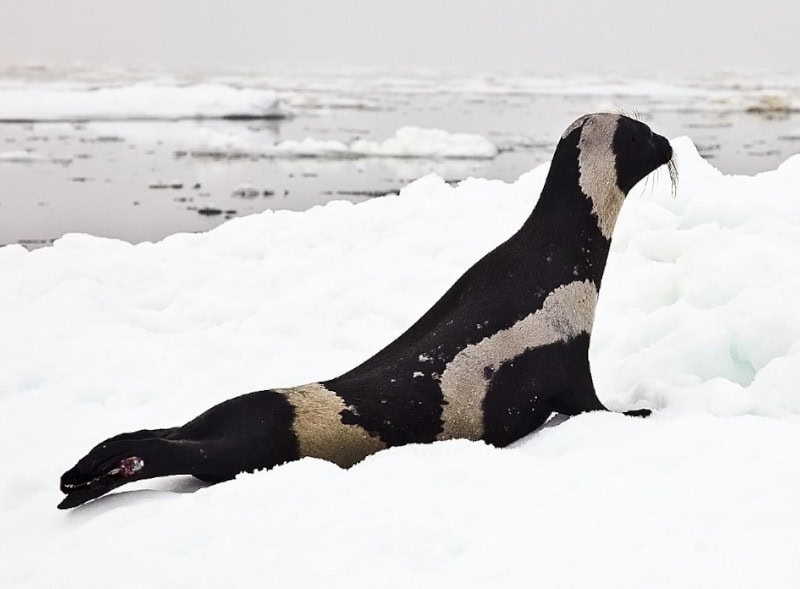
Ribbon Seal Facts
- The short yet descriptive term of Ribbon Seal serves as the most frequently used common name for this remarkable pinniped. For the moment, this intriguing product of Nature and evolution has no other widely accepted general name it’s known by.
- Among scientific professionals, however, it’s better known by its technical name. Unfortunately for the layperson, that’s an extremely difficult to pronounce title. That’s because this marvel of creation bears the formal moniker of Histriophoca fasciata.
- It received that name due to the efforts of the gereman zoologist, Eberhardt August Wilhelm von Zimmermann. He accomplished the first official recognition of it as a separate and distinct species. He managed that scientifically noteworthy deed in 1783.
- Regardless of which of these terms one chooses to use, it remains an impressive species. It further stands out due to the fact that it’s the only known member of its genus. Though certainly not unknown, that’s relatively uncommon, distinguishing it.
- Fortunately, the beautiful Ribbon Seal seems to be maintaining a population base that’s both sizeable and relatively stable. That situation also appears to hold true throughout the entirety of its range. The IUCN, therefore, presently lists it as Least Concern.
- Nonetheless, the animal faces several potential threats to its continued existence, at least. Most of these stem either directly or indirectly from the actions of humans. These include such perils as habitat loss, and of course, the looming threat of climate change.
Related Articles
Ribbon Seal Physical Description
The visually distinctive Ribbon Seal rightfully garners much attention from those who encounter it. The animal does so, however, due to a combination of factors. Its unique appearance ranks as one, to be sure, but it also merits appreciation due to sheer size.
In addition to these aspects of its nature, it also keeps with a pattern common to its relatives. That’s in the fact that it displays the physiological characteristic of sexual dimorphism. However, among this specific Pinniped, that trait appears to a minor degree.
More specifically, males generally attain a slightly greater body size than their female counterparts. The difference remains small enough that it’s rarely detectable visually by untrained observers. Overall, however, members of both sexes reach respectable sizes.
As a general principle, though, mature adults reach a body length measuring approximately 5.2 ft (1.6 m). Those same fully grown specimens typically attain a body weight of around 209 lb (95 kg). Though exceptional individuals occur, these rarely grow much larger.
In global appearance, however, the genders of the Ribbon Seal remain virtually indistinguishable. It’s this aspect of the creature that stands out the most for most observers. Mature specimens have a black backgroun, with four white markings on parts of the body.
The general body shape strongly resembles other seals, though. This develops as elongated in form. The head has a short snout, with deep, broad, internal nostrils. The large eyes are set deep into the skull. It also has a large external inflatable air sac, used for vocalization.
- Kingdom: Animalia
- Phylum: Chordata
- Class: Mammalia
- Order: Carnivora
- Family: Phocidae
- Genus: Histriophoca
- Species: H. fasciata
Ribbon Seal Distribution, Habitat, and Ecology
The impressive Ribbon Seal evolved as native to a comparatively broad swathe of the globe. The nature and location of that precise range, however, likely comes as no surprise to anyone. That’s because it’s endemic to portions of Earth’s Arctic and sub-Arctic zone.
There, the intriguing mammal lives in various sections of the North Pacific Ocean. The great majority of its population, however, prefer to make their home in one of two areas of that greater region. These habitat zones consist of the Sea of Okhotsk and the Bering Sea.
For the moment, it’s unknown if the fascinating animal ever appeared anywhere outside of its present range. In all the regions it does appear in, though, the mammal displays clear choices for its habitat type. Individuals spend the vast majority of their time in the water.
Researchers still know little about where it spends most of its time while at sea. Most remain far from land, and thus away from easy observation by scientists. A few individuals have been seen far outside this area, though. One appeared off the shores of California!
Like others of its kind, the Ribbon Seal evolved as a carnivore. Given its habitat, its diet consists almost entirely of small sea ceatures. This principally includes such prey as numerous small fish, like the Arctic cod, smaller squid and octopi, and crustaceans, as well.
While at sea, their main predators include Orcas and Great White Sharks. While on land, however, very few creatures seem to disturb them. Mating takes place in both the winter and spring seasons. This mainly occurs on the ice in the Bering Sea and Sea of Okhotsk.
Species Sharing Its Region
Check out our other articles on 3 Enchanting Marvels of Ethiopia, Axolotl, Cumberland Falls, Philippine sailfin lizard, Appalachian Avens, Franklin’s Bumblebee, Pesquet’s Parrot, Green Iguana
